I’m in California right now and I overheard in the aisle of Costo the other day, two women talking. As soon as I heard the stumbling pronunciation of Cinque Terre, I paused nearby with my cart, pretending to be interested in men’s pants.
Woman A had recently been to the Cinque Terre and was telling Woman B, (who she’d clearly bumped into in Costco) that she just had to go to the Sinky Terra. Woman B apparently was planning a European trip but had not decided where to go.
I very much wanted to interject and say, no, you don’t have to go there. There are 300 kilometers of coast in Liguria.
But I was pretty sure neither would know what I meant by Liguria. For the past 25 years I’ve been planning trips to Italy for Americans and I can say those who are sure they must go to the Cinque Terre, usually have no idea it’s in a region called Liguria. Most assume it’s in Tuscany as that’s usually the only region they’ve heard of—which is understandable.
The use of the word Tuscany in marketing has been at a fever pitch ever since the success of Frances Mayes’ books prompted Drexel Heritage to introduce a “At Home in Tuscany” furniture collection. Just yesterday in Home Depot I saw “Tuscany Series Vinyl Windows” advertised.
And don’t forget fast food chains who realized the word Tuscan could sell red rocks to Arizona. At Dominos you can get “Tuscan Salami & Roasted Veggie Artisan Pizza”, while Papa John’s offers “Tuscan 6-Cheese and Italian Herb” cheese sticks and Wendy’s sells a “Tuscan chicken sandwich”.
Back to the women in Costco. I thought about saying “excuse me” to them, but I didn’t know how to without looking rude (or at least entirely random).
I listened as Woman A explained to Woman B how she’d found the best hack by leaving the tourists on Vernazza’s tiny beach and walking over the rocks and swimming off the rocks. She kept repeating, “I just swam off the rocks! You really have to go there and do this!”
I couldn’t help thinking, there are other rocks next to other patches of sea in Italy.
Americans have been obsessed with visiting the Sinky Terra1 ever since Rick Steves proclaimed Vernazza to be “the best escape of the entire Mediterranean coastline.”
And this obsession has become a problem.
Here is what I had to say in my summer 2019 newsletter about tourism in the Cinque Terre:
One of the hot spots for selfie-tourism is the Cinque Terre. 2.5 million tourists pack themselves into these small and fragile villages yearly.
Their saturated Instagram photos make millions of others think it is something they too must check off. One result is ill-equipped tourists on the trails who need to be rescued by helicopter, which costs 5,000 euro per hour to us tax payers.
Instead of appreciating the local wine, (from grapes grown on Cinque Terre's terraced mountains), the tourists now order bucket-sized margaritas with bottles of Corona upended in them, which apparently local bars have learned is required by tourists?
Geez, let’s make the Cinque Terre look like Cancun on spring break why don’t we?
In spite of efforts by locals and the mayors of the Cinque Terre to limit the number of tourists, the cruise ships numbers are INCREASING in the Cinque Terre.
750,000 cruise ship passengers are expected this year, compared to 450,000 last year. This year the mayor of Riomaggiore even said she would "lock the train station" and not let tourists into her village because her village can't take it anymore.
Last year, (2023) a record four million visitors descended on the five villages. 2024 is surpassing those numbers.
These villages which have fewer than 4,000 residents are not equipped for such a deluge.
In high season tourists must let train after train go by because they’re too full. Once there, it can take forever just to get into the towns from the train stations due to tourists clogging the tunnels to the point where everyone is at a standstill.
Cemeteries in the villages had to be closed because selfie-obsessed tourists were doing photo shoots on the tombstones of the locals’ grandparents.
And the Via dell’ Amore? It used to be just a simple, beautiful, quiet trail. From the 1980s up to the year 2000, when I walked it, there was no fee, and no crowds.
Guess what’s happened to it now? To walk on it, you must secure a time online, pay 5 euro, and join a 30-minute tour of up to 30 people. A tour? For this simple trail? Yes, it’s beautiful, but it’s also quite short compared to the other trails. And while I understand why it has happened, my mind can’t reconcile this latest development with how the location was once.
The serenity was what I loved. It’s what we all loved about the CT before mass tourism.
We went for the rugged mountains with their precipitous drops to a seascape so endless you could sense it wrapping around the horizon.
We went for the chats with the elderly locals sitting on the benches, the sight of the white bearded man bringing in the catch of the day from a painted boat, the taste of Sciacchetrà under the moon. We went for the slowed-down pace, the other-worldliness, the quiet.
While the villages, the mountains, the sea, are still beautiful, there is, for those of us who knew it before, a sense of loss. The particular serenity we loved is gone. And with anything that we’ve loved and lost, there’s grieving.
Accommodation was cheap there through the 1990s. There were very few hotels outside of Monterosso.
In 1993 I went in early spring with my boyfriend by train from Lugano, where I was living. An elderly woman in Vernazza’s center led us to a room in her house. We were the only tourists in the restaurant next to Vernazza’s harbor and we had the trails to ourselves.
Unfortunately I can’t find any of my other photos from that bygone Vernazza.
Ten years later, in 2003, I was living in Florence running a wedding business. Hesitant to accept requests for weddings in the Cinque Terre, knowing the toll tourism was taking on the region, I’d gone knocking on the Vernazza town hall door to check things out with the mayor.
Without much prompting, he lamented to me about the changes the tourist boom had brought to his village. “The Cinque Terre are losing their culture, their traditional way of life. Hardly anyone works the land anymore. The vineyards are owned by cooperatives now, and the locals no longer cultivate the special wine of the region. The youth are concerned only with making money.”
“They aren’t interested in preserving local traditions?” I asked.
“They’re oblivious. They’re ignorant about the original culture of the villages.” He told me he was born in Vernazza, and in his younger days, only a handful of tourists came—and only in July and August. “Now, the prices are ridiculous in the restaurants. I keep hoping those prices and the new fees to use the trails will deter tourists, but the problem only gets worse each year.”
When I was there in 2009, I overheard elderly Italians in Riomaggiore talking about the American college kids who’d partied through the village the night before, sending their beer bottles rolling loudly down the steep streets.
Around that same year, mega cruise ships docking at La Spezia added the Cinque Terre to their shore excursion options, creating a new channel of tourists, which fed into the already unsustainable numbers.
The price of accommodation shot through the roof, restaurants had waiting lists, long lines developed outside gelato shops, and elderly locals were unable to pass through the crowds to reach the train station.
High crowds can create high tension. The restaurant food is not as good as it once was, and prices are high. Service in restaurants can be rude, or totally uninterested in you.
The authentic encounters I had with locals there are long gone. I don’t think I’ve seen a place change so much in such a short time.
These days, the mayor of Riomaggiore, Fabrizia Pecunia, who seems to be the most outspoken, complains of day-trippers arriving without knowing anything about the Cinque Terre. “They turn up, take selfies, eat a gelato, and go.”
When the CT was getting popular with selfie-tourists, I saw young Japanese women on the trails in slippery dainty sandals, no doubt to match their strappy dresses. I wanted to say, hey gals, please pair your cute dresses with hiking boots, there are no fashion police on these trails.
The ill-prepared, the unaware of how to hike types needed to be rescued too often, and now there’s a rule prohibiting anyone from entering the trails in any type of “open” shoe. Your shoes must be closed and have a non-slip sole. Caught without such shoes, you risk a hefty fine of €2500— that’s a fine far higher than what many of the badly behaved tourist in Rome and Florence have had to pay for defacing precious monuments.
I’m not here to say don’t go. What I want to say is be aware ahead of time of the impact over-tourism has on a place.
I want to suggest thinking out of the box. You don’t have to go a place because Rick Steves trumpets it.
I want to suggest examining a map of Liguria and understanding how many other seaside town there are.
And, I want to suggest that you prepare yourself for extreme crowding and for the resulting discomfort if you go to the Cinque Terre in high season. Being prepared can help lessen negative reactions.
If you must go to the CT, don’t be a day-tripper. You will wait in line to get on the trails, you’ll wait in line to get a gelato, you’ll wait in line to get a train back where you came from. You will add to the crowding of the trains that makes it impossible for locals to board a train when they need to get to a doctor.
Stay a few nights. Get out early in the morning before the crowds. Stay out late after day-trippers have left and you’ll have a chance of actually finding some serenity you can sink into.
High season in the CT starts at Easter and lasts through October.
While the villages shut down to a large extent in winter, you could try going in early spring before easter, when the villages are coming to life again. You’d be able to hike without the crowds (if you’re blessed with weather that allows for hiking).
Or, consider other lovely towns on the 300-kilometer Ligurian coast.
Lastly, please don’t go to the CT for selfie-tourism. Selfie culture promotes self-involvement rather than social responsibility.
Don’t travel to post and boast.
These villages were not placed there for the backdrop of your social media platform. Nor were they placed there as a party-land for American youth who want to get drunk.
Remember, people actually live in these villages.
Part 2, Overtourism in Florence, Venice & Rome
Not trying to throw shade. There are plenty of languages I don’t speak and words I wouldn’t be able to pronounce. I understand cinque is a tough one. But I’m always curious why 99% of American tourists I’ve ever heard talking about the Cinque Terre, insist on making the e at the end of terre, an a. Any thoughts on that? Do we have words in English that end in e but are pronounced with an a? Just curious.





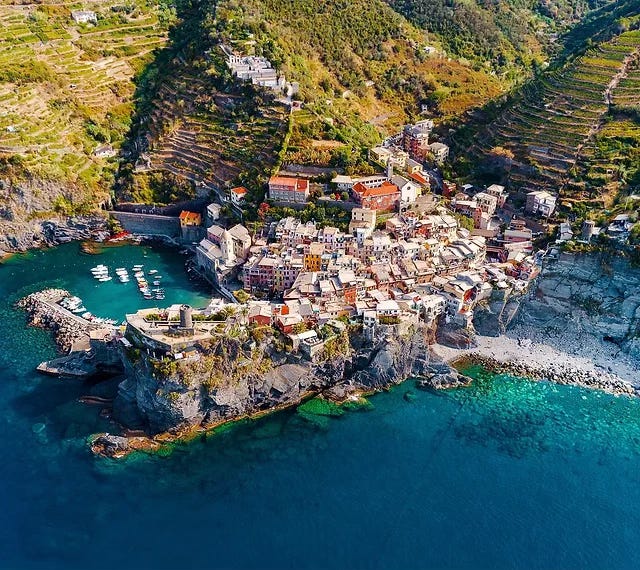
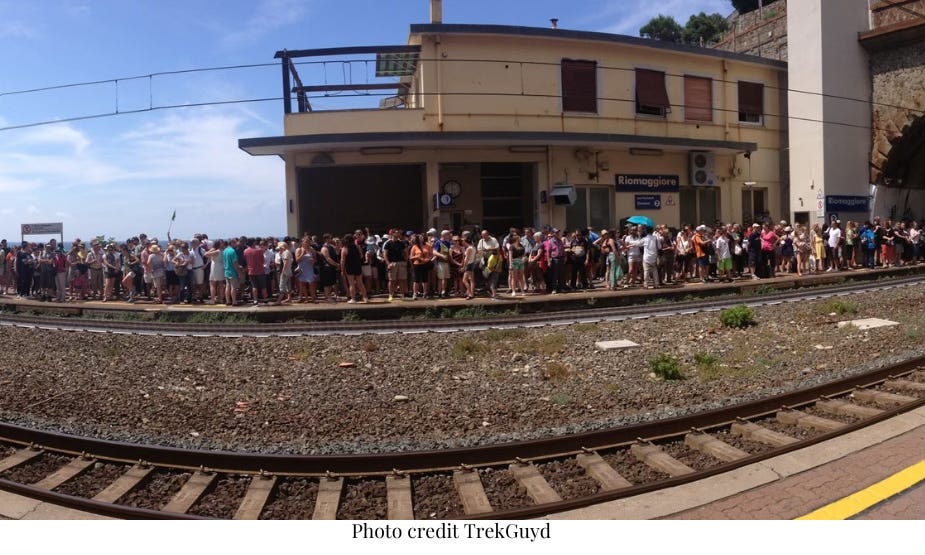
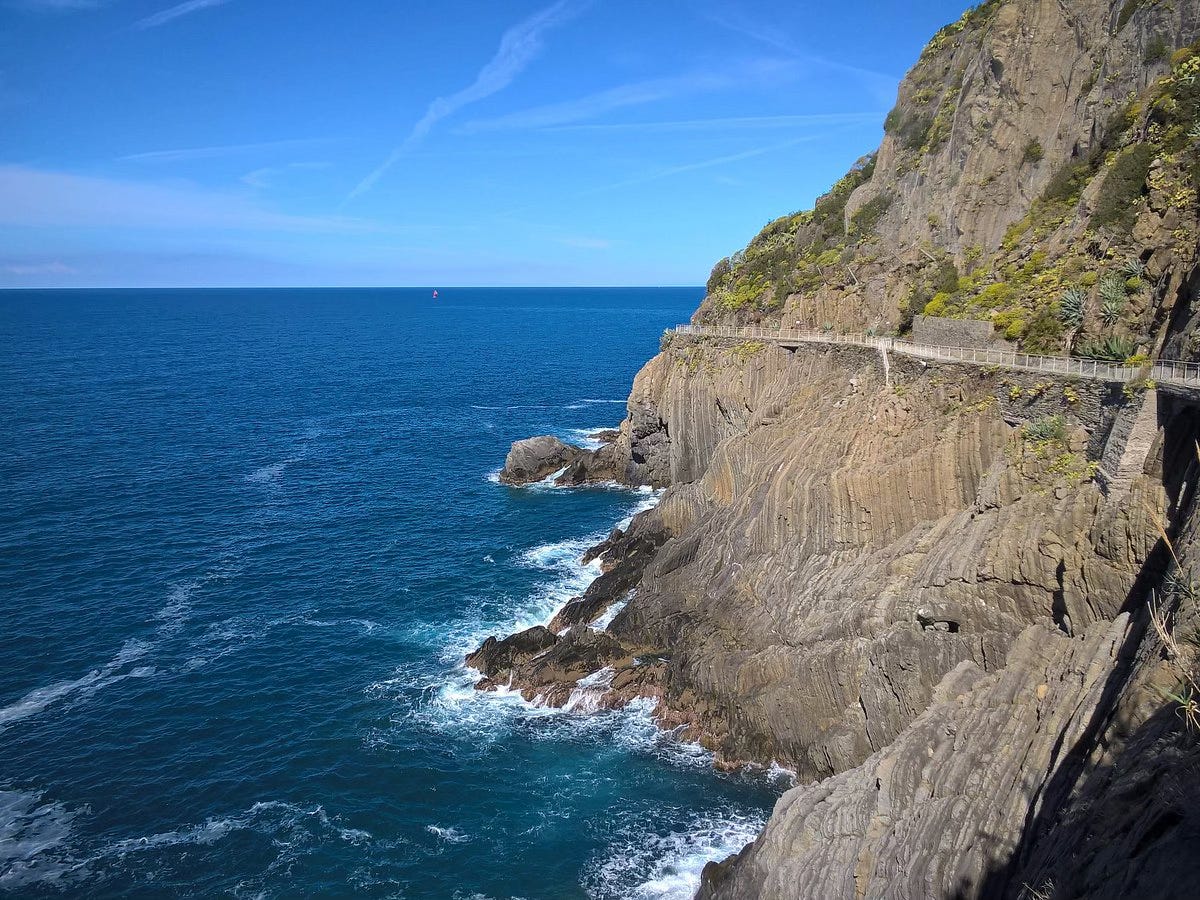

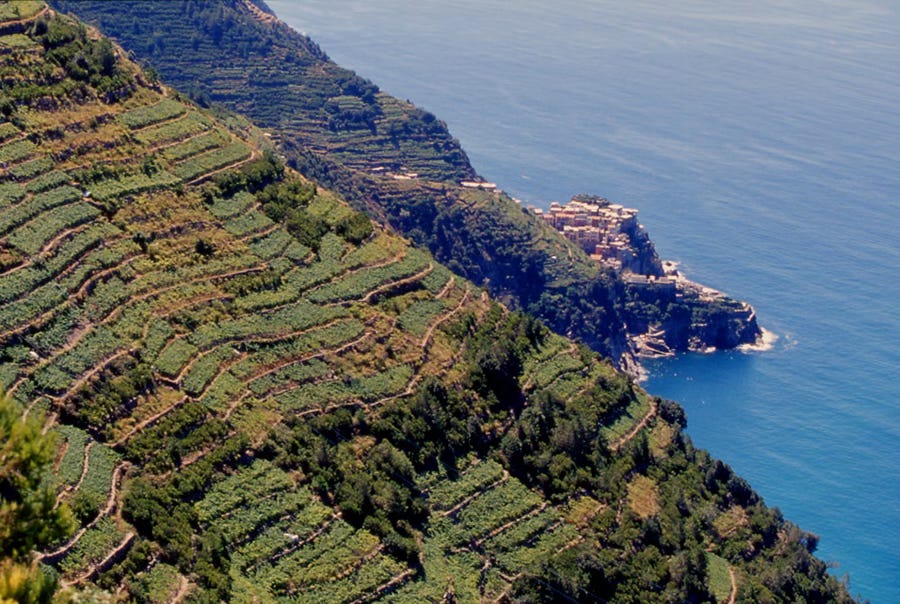
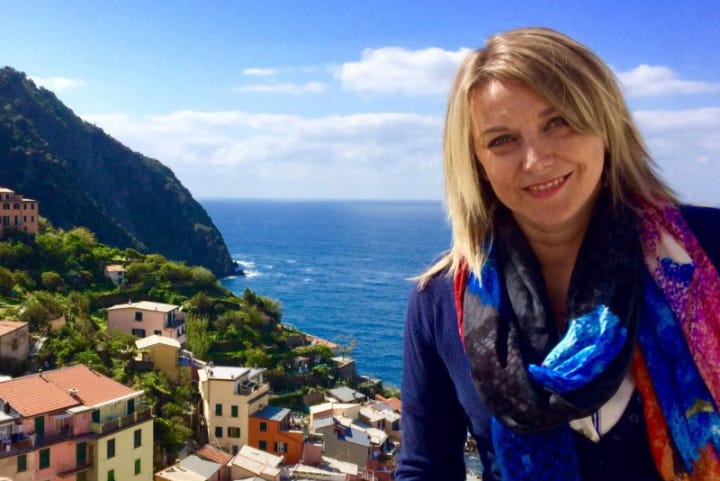
Chandi, This article is so well thought out and written. And so important. You had me at Tuscany Series Vinyl Windows. I'm in process of writing a similar article about overtourism in Como. We are less experienced with budget overtourism and the consequences are disastrous for residents and inconvenient for tourists who expect a city ready for ease and transport of unprecedented numbers of people.
Sooner or later, people have to stop using TikTok as their primary source of travel information-- it's reducing the whole of the Mediterranean to a place where you sip a spritz and shoot a photo. When I'm in Rome or Florence, I keep thinking that Italy is absolutely maxed-out on tourism. But then when I go just outside to Tuscia, Umbria, Marche and other places I realize that there are literally thousands of incredible locations to see that are almost empty, even in high season. Somehow, the country has to find a way to spread these visitors out into regions and towns that have just as much to offer as the major tourist centers. As you so aptly explained: there are other beaches with sea and rocks to swim from.